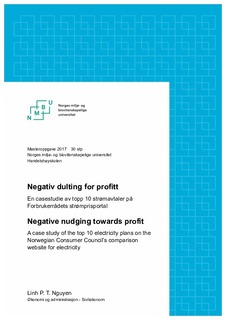| dc.contributor.advisor | Alfnes, Frode | |
| dc.contributor.author | Nguyen, Phuong Linh Thi | |
| dc.coverage.spatial | Norway | nb_NO |
| dc.date.accessioned | 2017-10-05T12:36:14Z | |
| dc.date.available | 2017-10-05T12:36:14Z | |
| dc.date.issued | 2017 | |
| dc.identifier.uri | http://hdl.handle.net/11250/2458732 | |
| dc.description.abstract | Strøm er et produkt som alle har behov for, og med daglig forbruk er strømregningen noe som må betales jevnlig. Per dags dato er det svært få forbrukere som er aktive i strømmarkedet, og de har generelt lite kunnskap om hvordan det fungerer. På grunn av dette, blir deres beslutninger angående strømavtaler ofte ikke tatt under full informasjon, og strømleverandører drar nytte av dette for å maksimere sin fortjeneste. Formålet med Forbrukerrådet sin strømprisportal er å gi forbrukere sammenlignbare avtaler, men likevel ser det ut til å ikke fungere maksimalt. Det som er interessant å se på er hvorfor det ikke fungerer, i tillegg til hva, og hvorfor det er vanskelig for forbrukere å velge en god avtale. Med den bakgrunn er problemstillingen:
Hvilke metoder bruker strømleverandører for å påvirke forbrukere med begrenset rasjonalitet i valg av strømavtale?
Oppgaven utføres som en casestudie av topp 10 strømavtaler på Forbrukerrådets strømprisportal – strømpris.no. En gjennomgang av portalen, samt leverandørenes nettsider har blitt foretatt for å se på hvordan avtalene er blitt presentert. I tillegg, er det blitt dokumentert prisendringer for å se på avtalenes stabilitet i forhold til pris og plassering. Kvalitative primærdata er samlet inn fra tre dybdeintervjuer og to korte e-postutvekslinger, hvorav fire er fra offentlige organer og to er fra leverandørorganisasjoner. Sekundærdata blir også anvendt for å sammenligne, samt støtte opp funnene fra casestudien.
Resultatene fra casestudien indikerer at adferdsøkonomisk kunnskap er blitt anvendt; at strømleverandører, med avtaler liggende øverst på portalen, bruker blant annet valgarkitektur og dulting for å påvirke forbrukerne. Resultatene viser også at ulike markedsføringsteknikker og prissetting er blitt brukt, og dette støttes opp av de kvalitative funnene. Konsekvensen av dette er at det ikke er rettferdig for andre leverandører som opptrer redelig og ærlig i markedet, og at forbrukere blir villedet; spesielt da forbrukere med begrenset rasjonalitet. | nb_NO |
| dc.description.abstract | Electricity is a product that everybody needs and consumes daily, such that electricity bills must be paid regularly. The energy market is a market where very few consumers have knowledge about and pay close attention to. Therefore, their decisions in choosing electricity plans are often not taken under full information, and energy suppliers benefits from this in order to maximize their profits. The objective of the Norwegian Consumer Council’s comparison website for electricity is to give consumers comparable offers, but somehow it does not fully work. It is interesting to find out why, in addition to what makes it difficult for consumers to choose a good offer, and why. The research question is as follows:
Which methods do energy suppliers use to affect consumers with bounded rationality in choosing an electricity plan?
This thesis is a case study of the top 10 electricity plans on the Norwegian Consumer Council’s price comparison website for electricity – strompris.no. A review of the comparison website and the supplier’s websites has been done to see how the offers have been presented. In addition, the price changes have been documented to look at the offer’s stability when it comes to price and ranking. Qualitative primary data is conducted through three in-depth interviews and two short e-mail exchanges, which three of this is with government agencies, and two are with energy supplier association. Secondary data is also collected to compare, and support the findings from the case study.
The results from the case study implies that elements of behavioral economics are used; that energy suppliers that have offers on the top 10 list uses choice architecture and nudging, among others, to affect the consumers. The results also show that different kinds of marketing techniques and pricing are used, and this is supported by the qualitative findings. The consequences of using these methods are that it is not fair to other suppliers who act fairly and honestly, and that consumers are misled; especially consumers with bounded rationality. | nb_NO |
| dc.language.iso | nob | nb_NO |
| dc.publisher | Norwegian University of Life Sciences, Ås | nb_NO |
| dc.rights | Attribution-NonCommercial-NoDerivatives 4.0 Internasjonal | * |
| dc.rights.uri | http://creativecommons.org/licenses/by-nc-nd/4.0/deed.no | * |
| dc.subject | Strømmarkedet | nb_NO |
| dc.subject | Strømleverandører | nb_NO |
| dc.subject | Valgarkitektur | nb_NO |
| dc.subject | Dulting | nb_NO |
| dc.subject | Sårbare forbrukere | nb_NO |
| dc.title | Negativ dulting for profitt : en casestudie av topp 10 strømavtaler på Forbrukerrådets strømprisportal | nb_NO |
| dc.title.alternative | Negative nudging towards profit : a case study of the top 10 electricity plans on the Norwegian Consumer Council’s comparison website for electricity | nb_NO |
| dc.type | Master thesis | nb_NO |
| dc.subject.nsi | VDP::Social science: 200::Economics: 210::Business: 213 | nb_NO |
| dc.source.pagenumber | 82 | nb_NO |
| dc.description.localcode | M-ØA | nb_NO |

